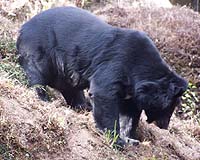| . |  |
. |
Madrid, Spain (SPX) Sep 28, 2010 A team from the National Museum of Natural Sciences (CSIC) has analysed the impact of climate change on spotted hyena survival in Europe over 10,000 years ago. These changes played an important role, but the scientists say studies are still needed to look at the influence of human expansion and changes in herbivorous fauna on the definitive extinction of this species across the continent. "Climate change in the past was not directly responsible for the extinction of the spotted hyena in southern Europe, but it was a factor in its disappearance", Sara Varela, lead author of the study and a researcher at the National Museum of Natural Sciences (CSIC), tells SINC. According to the study, which has been published in the Journal Quaternary Science Reviews, the hyena populations of Africa and Eurasia became separated during the glacial maximum. And "the climatic conditions in southern Europe 21,000 years ago were extreme for this species", says Varela. At that time, the European climate was undergoing "drastic" changes, as were herbivorous fauna populations and human expansion. According to the expert, "the survival of the hyenas could have been affected by the combination of these three factors acting in synergy, but not by the action of the climate alone". Her team studied climate change in the past and identified the most favourable areas for the hyena in Europe, using modelling to look at the various climate scenarios of the Pleistocene. A second model estimated the severity of climate conditions for the survival of these animals. "The climatic conditions in the south of Europe were at all times within the tolerance range of this species", Varela points out.
Everything happened in the late Pleistocene The distribution of the spotted hyena, a carnivore that is common in sub-Saharan Africa, has changed "substantially" from the Pleistocene until the present. Today it is only found in Africa, but during the Pleistocene (almost one million years ago), the spotted hyena also inhabited Eurasia.
Share This Article With Planet Earth
Related Links FECYT - Spanish Foundation for Science and Technology Darwin Today At TerraDaily.com
 Reformed hunter battles to save Bangladesh's wildlife
Reformed hunter battles to save Bangladesh's wildlifeSrimongal, Bangladesh (AFP) Sept 27, 2010 Sitesh Ranjan Deb says his transformation from hunter to conservationist was triggered 20 years ago when he was attacked by a Himalayan black bear while out stalking deer. Sitesh, from northeastern Bangladesh, stumbled on the sleeping beast. It lashed out, severely damaging his face and one eye, and only emergency surgery saved his life. During many long months of recovery, Sitesh decide ... read more |
|
| The content herein, unless otherwise known to be public domain, are Copyright 1995-2010 - SpaceDaily. AFP and UPI Wire Stories are copyright Agence France-Presse and United Press International. ESA Portal Reports are copyright European Space Agency. All NASA sourced material is public domain. Additional copyrights may apply in whole or part to other bona fide parties. Advertising does not imply endorsement,agreement or approval of any opinions, statements or information provided by SpaceDaily on any Web page published or hosted by SpaceDaily. Privacy Statement |